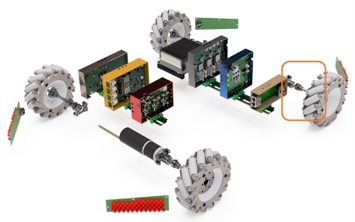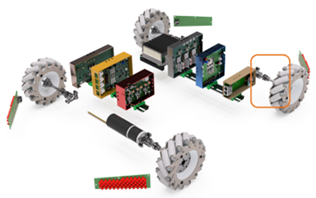Lighting, sensors and communications technologies are key enabling technologies for autonomous mobile robots (AMRs), allowing them to see, sense and interact with the real world. This blog reviews essential considerations when designing these subcomponents and presents solutions from onsemi that are suitable for each application.
Figure 1: An Autonomous Mobile Robot Concept
Sensing the Environment
AMRs need to be able to monitor and interact with their environment, and this requires using different types of sensors, including temperature sensors, image sensors, LiDAR (for 3D mapping), rotational position and visual light communication (VLC) sensors.
Image sensors and image signal processors give an AMR visual perception to navigate its environment to detect and recognize objects. For this application, onsemi offers a choice of global shutter and rolling shutter image sensors. The AR0234CS image sensor incorporates a new innovative global shutter pixel design optimized for accurate and fast capture of moving scenes at 120 frame per second, full resolution. The sensor produces clear, low noise images in both low−light and bright scenes.
Figure 2: onsemi Sensing Solutions for AMRs
Position sensors measure the rotation of an AMR’s wheels and other moving parts, allowing it to track its three-dimensional position and orientation accurately. onsemi’s NCS32100 is an industrial rotary position sensor which combines accuracy and speed. It features a 38mm sensor and delivers +/-50 arcsec accuracy at 6,000 RPM. For lower-accuracy applications, it can support speeds up to 100,000 RPM. This new device uses a patented approach to inductive position sensing which is ideal for industrial and robotic applications.
Ultrasonic and infrared sensors measure the distance to remote objects, enabling an AMR to detect obstacles and avoid collisions.
Lighting the Way
Lighting technologies, like light-emitting diodes (LEDs), allow AMRs to navigate, communicate and operate in challenging environments. They can also be used for signalling and to indicate the status or direction of a robot. Performance characteristics and parameters to consider when selecting lighting technology for an AMR include brightness, color temperature and power consumption. LED controllers and drivers are components which monitor the current flowing in LEDs and enable them to emit light of a specific intensity and wavelength. LED driver circuits use high-side and low-side power MOSFETs to switch on and off the LED current and protect against overvoltage and overcurrent conditions while also ensuring the stability of the LED driver circuit. The NVC7685 LED linear current driver and the NCL31000 from onsemi are intelligent LED drivers ideal for AMR lighting applications. The NVC7685 has twelve linear programmable constant current sources with a common reference, allowing 128 different PWM-adjustable duty cycle levels. The NCL31000 features a high-efficiency 3 Amp buck LED driver that supports high-bandwidth analog and PWM dimming (down to zero current), two auxiliary DC-DC converters, and diagnostics to monitor input and output current and voltage, LED temperature, and DC-DC voltages.
Figure 3: onsemi Lighting Solutions for AMRs
The NCL31000 supports VLC which uses visible light as a carrier for transmitting unidirectional data up to 10kb/s. VLC allows an AMR to securely communicate with other devices and humans. Since visible light spectrum is 430 THz to 790THz, VLC will not influence nearby wireless technologies like Bluetooth® Low Energy (Bluetooth LE), Zigbee, ultra-wideband (UWB), and Wi-Fi. VLC is secure because it is inherently limited to line of sight. AMR’s navigating in warehouse applications benefit from UWB, Bluetooth LE (AoA/AoD) and Wi-Fi Indoor Positioning Systems (IPS). But sometimes radio frequency (RF) congestion or interference can compromise IPS. To mitigate against this, VLC can be used to complement existing RF IPS by installing VLC into the ceiling luminaire grid, where each ceiling luminaire transmits a unique ID#. If the AMR contains a floorplan database containing each luminaire position and unique ID, the AMR can self-navigate with a simple photodiode facing the ceiling as depicted in Figure 4 below.
Figure 4: AMR’s using VLC for Indoor Positioning Systems (IPS)
Communicating with the Real World
Communication technologies enable AMRs to transmit data and receive commands to other devices and systems. Parameters to consider when selecting a communication technology for an AMR include its operating range, data rate, power consumption and security. The operating range must be sufficiently long to communicate with other devices and systems in the immediate environment at an acceptable speed. The transceiver’s power consumption must be as low as possible to preserve battery life, while security is critical to prevent AMR data and commands from being corrupted.
Bluetooth LE wireless communication technology is designed for low power consumption, making it ideal for battery-powered devices. This protocol supports a range of data transfer rates for transmitting sensor data and control signals between an AMR and other devices. Bluetooth LE can also be used in indoor positioning systems to enable AMRs to navigate dynamic environments. onsemi’s RSL15 is a Bluetooth 5.2 certified transceiver for easy-to-implement Bluetooth LE wireless applications, supporting AOA (Angle of Arrival) and AOD (Angle of Departure) key features to enable accurate Indoor Positioning. The highly integrated radio system on chip (SoC) optimizes system size and battery life. It features an ARM Cortex-M33 processor and a 2.4 GHz transceiver, which supports Bluetooth LE 5.2 and 2.4 GHz custom protocols.
Figure 5: onsemi communication Solutions in AMRs
Industrial Ethernet communication protocols provide the high-speed communication capabilities required for controlling and coordinating multiple AMRs in real-time. onsemi’s NCN26010 10BASE-T1S, industrial Ethernet transceiver, enables multi-drop Ethernet communication for industrial applications using existing twisted-pair wire cabling. This device is IEEE 802.3cg compliant and includes a Media Access Controller (MAC), a PLCA Reconciliation Sublayer (RS), and a 10BASE−T1S PHY designed for industrial multi−drop Ethernet. It provides all physical layer functions to transmit and receive data over a single unshielded twisted pair, and it can communicate with a host MCU using the Open Alliance MACPHY SPI protocol.
Guiding AMR Component Selection
The whole purpose of AMRs is to interact positively with the real world, and onsemi can support designers in selecting the best lighting, sensing and connectivity solutions to make this possible. To learn more about power and motor control solutions within AMR, read our first blog on “How onsemi’s Power and Motor Control Solutions can be used for Autonomous Mobile Robots”
Watch our AMR video here.




